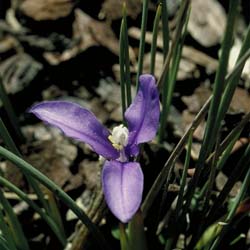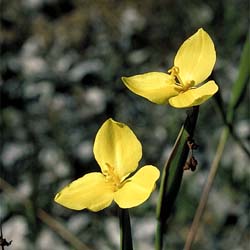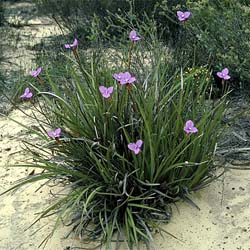Patersonia species
 Patersonia fragilis |
 Patersonia xanthina |
 Patersonia occidentalis |
Native Iris or Native Flag
Full list of Patersonia species
The genus Patersonia includes about twenty species of small strap-leaf plants resembling the exotic iris whose family, Iridaceae, is not well represented in Australia. As a result members of the genus Patersonia are frequently referred to as native iris or flag.
They can be found over most of temperate Australia and make showy rockery plants either singly or en masse. They need good drainage and a full sun although there are one or two exceptions to this general rule which will be dealt with later in this article.
Patersonias are erect herbs with short rhizomes, linear leaves and regular three-petalled flowers in terminal clusters enclosed in two large papery bracts. The flower colour varies with the species - white or yellow is rare and usually they are blue through purple with soft delicate petals. Individual flowers open for less than one day but many flowers are produced from the one stem. All plants in a single area will flower on the same day making an impressive display when massed.
The fruit is a long, three-celled capsule triangular in cross section with abundant seed which germinates readily with no special treatment. Young plants should be planted out at 30-40 cm centres. Some success has been achieved by dividing clumps, but this is not a reliable method of producing new plants. All are moderately frost tolerant.
Patersonia fragilis has greyish-green, twisted leaves to 45 cm, often longer than the flower stem which bears blue flowers. As yet this species has had limited success at the Australian National Botanic Gardens but a sandy soil and better drainage may improve its performance. It may be found in south-east Australia from southern Queensland to South Australia including Tasmania.
P. glabrata from Queensland, New South Wales and Victoria is recommended as a rockery plant in a sunny situation. It has erect, dark-green leaves 15 - 30 cm long and blue to light-purple flowers.
P. longiscapa has clear blue to purple flowers held above the linear leaves which form a dense tussock. It is an attractive garden specimen particularly suited to damper areas and does well at the National Botanic Gardens. It is a free-flowering species for an open situation and occurs in Victoria, Tasmania and South Australia.
P. longifolia occurs on the coast and adjacent sandstone plateaus from near Sydney to eastern Victoria. It forms a small clump with flower stalks only 15 cm long and is useful as a rockery plant for damp, semi-shaded situations.
P. occidentalis is a frost-hardy plant which can withstand a dry situation and has proved a useful plant in the Canberra Gardens. It is a tall, free-flowering species occurring naturally in south-western Australia. As with other Patersonia species it flowers in the spring and carries through to early summer. Colour is blue to purple.
P. sericea is another reliable species with attractive silky leaves dark to greyish green. It has deep violet-blue flowers and thrives in hot, dry situations.
P. xanthina, a Western Australian species with yellow flowers in spring, is not common in cultivation and prefers a shaded position with good drainage. Plants have flowered in containers at the Australian National Botanic Gardens but have not proved reliable in the open garden.
Text by ANBG staff (1978)
Name meaning: Patersonia speciesPatersonia - in honour of Col. W. Paterson (1755-1810), Scottish traveller in South Africa in the 18th century; fragilis - brittle, fragile; glabrata - hairless (referring to the leaves); longifolia - long-leaves; occidentalis - western; sericea - Latin for 'silky hairs' referring to the silky hairs of the plant, longiscapa - long-stalked xanthina - from Greek, 'yellow'. |
![An Australian Government Initiative [logo]](/images/austgovt_brown_90px.gif)

